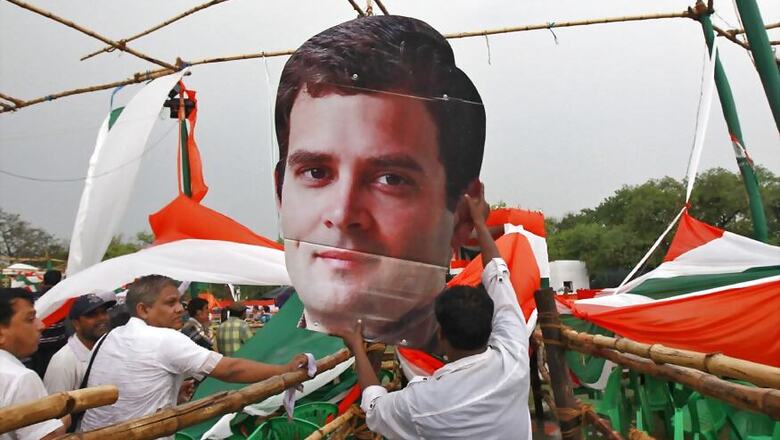
views
The people of Gujarat have spoken, basically to say they’ll stick with the BJP, for now. So, can Congress re-make itself enough to change the voters’ mind sometime in the future? Yes, going by the example of Britain’s Labour Party.
Twenty years ago, Labour managed one of the most remarkable instances of an electorally successful makeover. In a political age that leaned right, Labour reprised its centre-left message to win three general elections – two by a landslide and a third with a comfortable parliamentary majority.
How did the party do it? How did ‘New Labour’ emerge in 1997 from 14 years in the electoral wilderness? How did it go on to become the UK’s dominant political force for more than a decade? Is there a crib sheet that Rahul Gandhi’s Congress could re-purpose to its needs?
There are three key takeaways for Congress from British Labour’s metamorphosis:
Re-brand
It was Labour leader Neil Kinnock (his term ran from 1983 to 1992) who laid the groundwork for the ‘New Labour’ project. He initiated efforts to modernize the party visually. Kinnock hired a silver-tongued, media-savvy TV producer named Peter Mandelson, who would go on to change Labour’s perceived narrative, starting with the party symbol.
Mandelson advised that it was better to have a red rose rather than the red flag, which voters took to be proof of the party’s radical, even militant tendencies of destructive trade-unionism and a high-tax, strikes-and-socialism agenda.
Mandelson’s roots lay in Old Labour – his grandfather was a cabinet minister in Labour Prime Minister Clement Attlee’s government. But by instinct, he was part of the unformed idea that would later be born as ‘New Labour’. Both Kinnock and Mandelson knew that the electorate, or at least a decisive percentage of it, no longer wanted traditional Labour.
This was understandable, after a decade of Margaret Thatcher’s conviction politics, which rejected Britain’s post-imperial, post-war political consensus on industrial nationalization and expensive, state-led economic intervention.
There may be similar limits for Rahul Gandhi’s Congress in pushing the old secular message in a country utterly transformed by the self-regarding majoritarian argument of Hindutva, and 25 years after the Babri Masjid’s demolition
Go beyond a spray-paint strategy
There is no certainty that New Labour would have become one of the great election-winning forces in British political history had it done no more than wave an aerosol can around and spray paint the surface.
The New Labour project was much more than a simple paint job. The rebranding may have started with the party symbol but it went on to a re-casting of its core beliefs. After Tony Blair was elected leader in 1994, he set about reclaiming radical liberalism for Labour, creating the Third Way.
It meant the reconciliation of left-wing and right wing politics, a reassuring attempt to tell voters a Labour government would not return to an old-style economic war on capitalism and individual enterprise. But Blair also provided a heart, an emotional sub-text, to the cold hard logic of Thatcherism, with its ruthless privatisation, welfare cuts and worship of the free-market.
Blair introduced a doctrine of social and economic responsibility. “A decent society,” he told his party conference after winning the 1997 election, “is not based on rights. It is based on duty. Our duty to each other.”
New Labour, in Blair’s words, represented the defining purpose of society, “compassion with a hard edge”. Blair was a populist before populism swept the western world. He claimed to speak for ‘The People’, that is, all of the British people, the British nation. This allowed for an inclusive nationalism very distinct from the Them vs Us atmosphere of the Thatcher era.
There may be a similar sort of opportunity for Rahul Gandhi’s Congress to offer a re-made agenda that appropriates the polarising discourse of Hinduism but speaks for all the people.
Be genuinely new
It was the late Tony Benn, a pivotal figure in British left-wing politics in the second half of the 20th century, who properly explained the New Labour phenomenon. Blair, he said, did not change the Labour Party, he created an entirely new one.
This is true enough, though Blair didn’t do it alone. Kinnock began the process, fighting the extreme left, so-called Militant tendency. Meanwhile, Mandelson talent-spotted Blair and Gordon Brown, both new MPs in 1983, for the massive project of presenting Labour as a safe and reliable party of government.
The challenges were immense. In the 1983 general election, Labour suffered a landslide defeat, plugging a manifesto described as the "longest suicide note in history". It pledged unilateral nuclear disarmament and withdrawal from the European Common Market to an electorate suspicious of such nostrums. The last Labour government was remembered for economic paralysis and the "winter of discontent".
Blair, Brown and Mandelson began the makeover. The historic and heavily symbolic Clause IV of Labour's constitution, which called for the "common ownership of the means of production", was junked. Labour began a charm offensive to persuade the world of business it had learnt the virtue of financial responsibility, or "prudence" as Brown put it.
And ‘New Labour’ put heart into the hard edge of its promised agenda for governance. Its stock phrase, "Tough on crime, tough on the causes of crime", signified its new approach compared to its rival, the Conservatives. Labour would be as hard as the Conservatives on crime and criminality, but in a way that looked at fundamentals first.
Rahul Gandhi’s Congress has everything to play for. If it dares.
Rashmee Roshan Lall is a commentator on world affairs based mainly in London. She is on Twitter @rashmeerl and blogs at www.rashmee.com



















Comments
0 comment